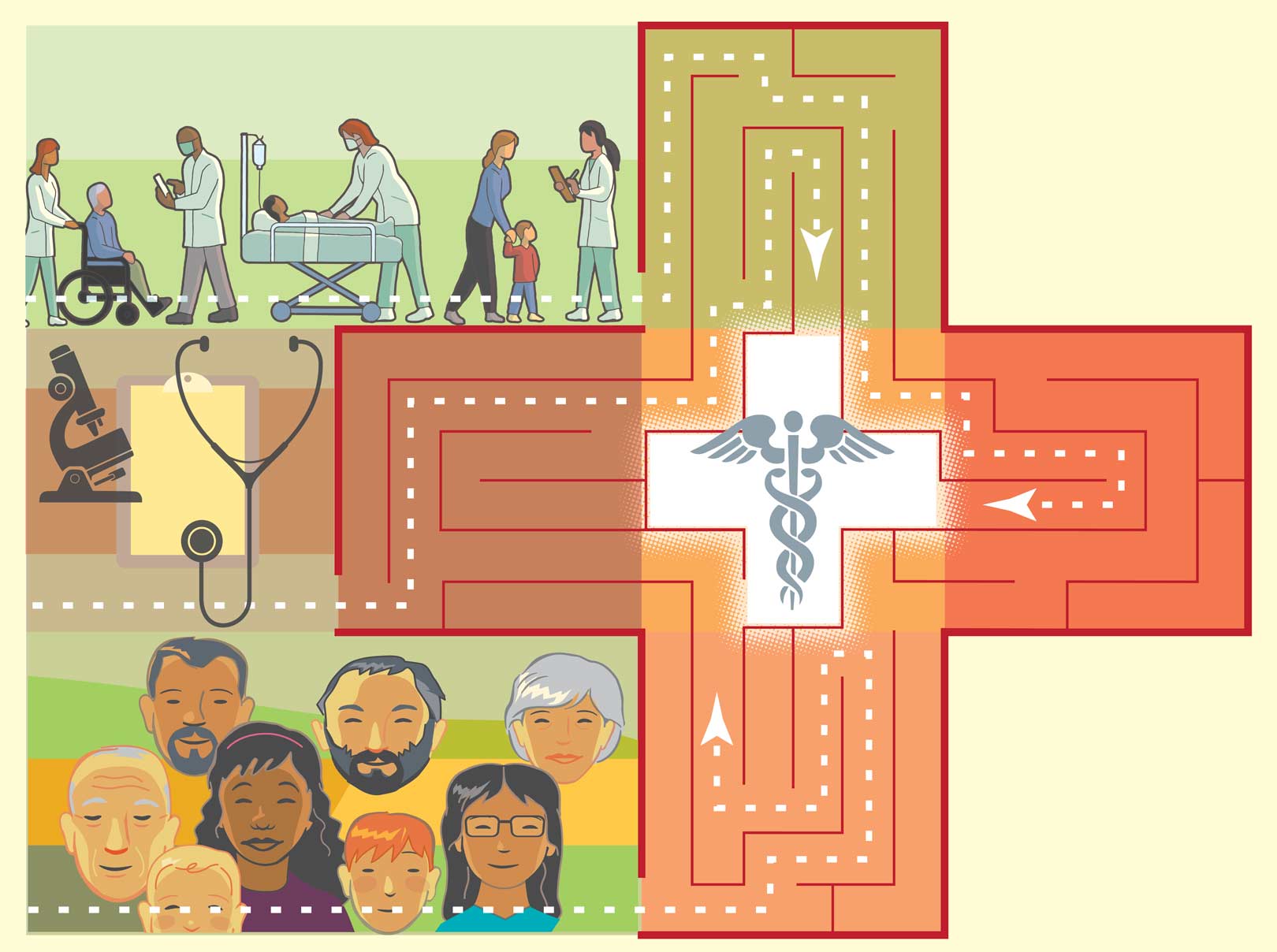
Primary care is the foundation of our healthcare system, but it is in critical condition. Can it heal itself?
Stories are still told of local 19th-century country doctors who spent their days and nights crisscrossing our region in sleighs or on horseback to care for their patients. Their jobs were not easy. One doctor reminisced that he was “oftentimes called at midnight in winter to visit patients many miles away, whose homes lay in the midst of forests, far from neighbours or help of any kind.”
Fast-forward to the twenty-first century and this simple portrait of rural healthcare is as unfamiliar as the horse-drawn cutter that doctor drove over the snowy fields.
In the 1930s, house calls made up about 40 percent of doctor-patient meetings. By the 1980s, the percentage had dropped to almost zero. Today, seeing a doctor anywhere, let alone in your home, is being relegated to the nostalgia section of our collective memories
The once-revered Canada Health Act of 1984, which promised to “facilitate reasonable access to health services without financial or other barriers” is eroding. Millions of people in Ontario (including thousands in the Watershed area) have no family doctor or access to primary care of any kind. Emergency departments are clogged with patients waiting long hours for non-urgent medical help simply because they have nowhere else to turn. A report on primary care released in March by the non-profit health organization, Commonwealth Fund, placed Canada last among ten countries, behind the United States. Last.
Remedies for this situation will require strong medicine, but one thing is sure: there is no going back to the way we were.
THE SEARCH FOR CARE
Twelve years ago Alan and Samantha Bland moved to Campbellford from Toronto. They put their names on a waiting list with the Trent Hills Family Health Team, and before too long they were on the roster of a family physician. How did they do it? “We were lucky that a new doctor had just opened a practice here,” says Bland, “so the wait was not long.” Today this kind of luck sounds too good to be true. More common is the story of Carly Thomson and her partner Linda Carducci (not their real names), who moved to Brighton from Toronto four years ago. They got on a list for a family physician in Trenton and considered themselves lucky to be accepted into the clinic after waiting two years. Then, “Our doctor decided to close up and move somewhere else,” says Thomson. Just like that, they were again without a primary care physician. It’s a sadly familiar story: physicians are leaving faster than they’re arriving.
The exact number of people in the Watershed region currently without a family physician is hard to pin down, but estimates are around 5 percent of the population, which could be as many as 8,000 souls. It is not uncommon for a family practice clinic waiting list to number in the hundreds.
Many family physicians retired during the pandemic, leaving open positions everywhere. Now an Ontario Medical Association survey suggests that 40 percent of its members are planning to retire in the next 5 years. Some of the vacancies will be filled, but possibly not here.
HOW DID THIS HAPPEN?
The causes are as numerous as bacteria in a Petri dish. Here are some:
Many family physicians retired during the pandemic, leaving open positions everywhere. Now an Ontario Medical Association survey suggests that 40 percent of its members are planning to retire in the next 5 years. Some of the vacancies will be filled, but possibly not here.
As much as we in the Watershed region love our home soil, rural areas are not always popular places to set up a practice. For example, earlier this spring there were six unfilled physician vacancies in Prince Edward County, with four more expected.
Compensation for family practice is not on par with other medical disciplines. An average Canadian family physician earns about three-quarters as much as a doctor in other specialties, even though family practice is now a recognized specialty in itself. Still, not even a third of recent med school grads have even thought of family practice as a career.
The Ontario Medical Association says that the federal government’s recent proposed changes to the capital gains tax could negatively impact physicians in Ontario. Family doctors are running small businesses, with all the usual overhead expenses; this extra drain does not create an incentive to stay in business.
The province’s tangle of antiquated record-keeping systems trapped in a mid-numbing maze of bureaucracy is leading to administrative burnout. Studies show that family physicians in Ontario can spend up to 19 hours per week filling out paperwork, a chore that is not compensated by OHIP.
The supply of doctors from elsewhere has not kept pace, partly because of the outdated system of licensing, which is not consistent from province to province across Canada. In addition, barriers faced by foreign-trained doctors still exist due to licensing issues as well as lack of recognition of their qualifications.
There are three dominant strategies for repairing the system in our region:
- Consolidate primary care into a team concept, such as Family Health Teams.
- Bring more nurse practitioners into the mix and develop a funding model for them.
- Make family practice a more attractive career path by increasing compensation, controlling workload and reducing paperwork.
TEAMWORK
Dr. Sarah LeBlanc is a model for today’s family physician. She studied medicine at Queen’s and fell in love with both Prince Edward County and rural healthcare when she was a medical resident here. She’s never left. “It’s the kind of medicine I wanted to practise,” she says.
When she speaks, her enthusiasm for her work is obvious – but what about those rumoured mountains of paperwork that inundate a family physician? It’s all true, according to Dr. LeBlanc. “But we deal with it because it has to be done. It’s part of the care our patients deserve.” Still, it’s tempting to wonder if spending countless unpaid hours filling out forms is what physicians were trained to do.
Although she has her own office in Picton, Dr. LeBlanc is fully integrated with the PEC healthcare community, carrying out home and hospice visits, working with long term care patients and with both in-patient and emergency care at Prince Edward County Memorial Hospital (PECMH) in Picton; she also serves as chair of the board of the Prince Edward Family Health Team. “This is how we are trained – to work in teams,” she says. “I am a medical expert, but I rely heavily on the expertise of other inter-professional colleagues.” She stresses much of the healthcare community’s success can be attributed to the strong collaboration between the medical professionals and the PECMH and Quinte Health.
Collaborative medicine is nothing new, but in the past 20 years it has inspired a new concept: the family health team, with physicians, nurse practitioners, nurses, physiotherapists, diagnostic services and community care workers all together under one umbrella. This integrated system aims to make it easier for patients to find the exact care they need without having to make their way through a complex network of practitioners. It also makes it less likely a doctor will have to treat something that could be better handled by another expert.
Barinder Gill is the executive director of the Prince Edward Family Health Team (PEFHT). The team is built on the province’s generic model, although “every team is different and responds to its own community,” says Gill.
His job is generally making sure the “wheels stay on the bus.” This includes monitoring the contract and the service accountability agreements the PEFHT has with the provincial government and negotiating the all-important funding requirements. The health team is a constantly evolving entity, so it’s necessary to keep on top of developments. With 16 physicians plus a full team of healthcare professionals, “it’s really one-stop shopping.”
Gill has lived in the Watershed region nearly all his life and has seen vast changes over the decades. He notes that the number of doctors required for the County’s family health team was determined many years ago, but the County looks far different today, with greater population and needs. However, the reality is that more funding, more staff and more treatment options will always arrive in their own time, and not always when asked for. Meanwhile, Gill remains upbeat and pragmatic: “Rather than wait around, we continue to do a lot more with less.”
THE FACE OF FUTURE PRIMARY CARE
One of the most impactful developments in primary health care has been the role of the nurse practitioner (NP). They could become the face of tomorrow’s primary care.
A nurse practitioner is a registered nurse with a graduate degree in primary care nursing. NPs diagnose medical conditions, prescribe medications, order and interpret diagnostic tests and perform procedures. NP positions were originally intended to respond to the needs of under-serviced areas or vulnerable populations in remote parts of the province. In recent years, however, their scope has expanded to the point where they are now considered the main primary care contact for people throughout the Watershed region, including health teams and family practice clinics.
NP Kathleen Foss knows what a perfect fit a nurse practitioner can be with a family practice. A nurse practitioner since 2005, she works with the Lakeview Family Practice Team in their Colborne clinic. Surprisingly, there is no OHIP fee structure for a nurse practitioner who works with a doctor. NP Foss doesn’t have her own roster of patients, and her salary comes out of the budget of the family physician who runs the clinic.
She likes working in a rural environment, in part because it’s easier to get to know her patients and their family histories, which in turn makes it easier to care for them. “If you don’t know the person,” she says, “you can’t treat them. You can’t look after someone with diabetes unless you know their lifestyle.” NP Foss’s responsibilities dovetail smoothly with those of the clinic’s physician, Dr. Iris Nolan. She sees her role as providing healthcare to all but the most serious or complex cases, envisioning a future where NPs will be in all family practices, collaborating with the doctors, each one contributing where they are needed the most.
TAKING THE LEAD
A nurse practitioner-led clinic is a primary care facility without a physician at the helm. The concept is brilliant and overdue – and there is only one anywhere near us.
Just off Pinnacle Street in Belleville is the Belleville Nurse Practitioner-Led Clinic (BNPLC). The facility is spacious, bright and clean, with lots of treatment rooms, offices for social workers and a large space for physiotherapy. There is even a midwifery clinic next door. The BPNLC has a staff of six NPs and three nurses, plus a chiropractor, a dietitian, social workers and a pharmacist – all under one roof.
Karen Clayton-Babb is the Chief Nurse Practitioner/Clinic Director at the BNPLC. Her background is a wealth of international education and training in healthcare. NP Clayton-Babb sees the clinic as a vital link in Belleville’s medical scene, as there are no walk-in clinics in town. People without primary care providers either seek help in the Emergency Department or do not seek it at all, she says. “In Emergency they’re seeing patients who should not have been there.”
She points out that in addition to being more accessible, an NP-led clinic offers a holistic, patient-centred approach. “It’s a human being sitting in front of you,” she says, “with a healthcare issue that may have been caused by a number of factors. Their environment and social challenges will affect their condition.”
Money for the BNPLC comes directly from the provincial government, which currently funds 25 nurse practitioner-led clinics across the province. Is there room for more of them in our area?
“We can easily do with more than one clinic in Bay of Quinte,” she says. The Belleville clinic is currently at capacity with 5,080 patients. In addition to a plan to open a satellite clinic north of Belleville, last year they collaborated with the Rotary Club on a proposal to set up another in Trenton, but neither project received funding.
Although NP Karen Clayton-Babb would change some things about the primary care structure, she wouldn’t change a thing about her career choice. “I love the area, I love the work, I love the patients.”
NP Foss likes working in a rural environment, in part because it’s easier to get to know her patients and their family histories, which in turn makes it easier to care for them. “If you don’t know the person,” she says, “you can’t treat them. You can’t look after someone with diabetes unless you know their lifestyle.”
VITAL SIGNS
Despite all the sobering news, there are steps being taken to bring primary healthcare into the twenty-first century. This spring, the provincial government pledged to address the paperwork nightmare, which could give doctors more time to see patients. Closer to home, the Trent Hills Family Health Team announced in April that it was adding more staff and was accepting applications from new patients.
A statement issued by Health Minister Sylvia Jones reported that the government has expanded medical school access by adding hundreds of undergraduate and medical positions. In March Premier Doug Ford announced that York University’s new medical school will be 70 percent focused on family practice. There is also evidence that more doctors who were trained in foreign medical schools are beginning to fill in the vacancies in family practice residencies. There is even talk of a new AI system that will help doctors with time-consuming note-keeping duties.
Meanwhile recruitment is in full swing. Adam Hambly is a respiratory therapist who has taken on the challenging portfolio of recruiting physicians to Prince Edward County. One way to do this is with his program, County Docs, promoting the County as a great place to live and work. “Practising medicine is basically the same anywhere in rural Ontario,” says Hambly, “so we need to emphasize our differentiators.” The County prides itself on a unique blend of rural lifestyle with sophisticated amenities like restaurants and wineries, so he says it’s not too difficult to paint an attractive portrait of life here.
So far, the PEC recruiting effort is just managing to break even: the new doctors who are arriving here are taking over for doctors who are about to retire. So, “there’s not a strong net gain as yet,” Hambly says. But with the momentum of six new doctors starting this year, the gap should slowly begin to close. There is another challenge he’s dealing with.
Health Care Connect is a Ministry of Health online program that helps patients find primary care. Needless to say, the waitlist is enormous, but Hambly has masterminded an innovative program to get patients off that list.
If there are not enough doctors, he thought, then maybe we can make it easier for those already here to take on more patients – a task usually considered nearly impossible, especially with the administrative overhead involved with each new patient. Hambly persuaded the municipality to fund a pilot program to enable physicians to hire extra help for their admin tasks, or even to hire another doctor temporarily. Four doctors are now participating in the pilot, and each has taken on 250 more patients. Hambly says the project will reduce the County waitlist by nearly 50 percent.
There is no guarantee these efforts will lead directly to a flood of family physicians deciding to move to our area. Even with more medical school graduates, financial incentives and lifestyle appeal, rural family practice doesn’t seem poised to become an irresistible option for new doctors anytime soon. In the meantime, as Barinder Gill says, we will continue to do more with less.
PROGNOSIS FOR PRIMARY CARE
“Primary care is called primary for a reason,” says Dr. Sarah LeBlanc. “It is the foundation of our healthcare system. And if the foundation is crumbling, it’s impossible to build on it.”
Band-Aid solutions to the old ways are not going to work. In today’s world, the idea of one person having one always-available family physician will soon be as out-of-date as the century-old image of a doctor in a horse-drawn cutter making their way across the dark, snowy fields to lance a boil in exchange for half a dozen eggs.
Tomorrow’s patients will be cared for by a team of professionals. If a pharmacist can administer a vaccination, if an NP can prescribe medication or refer you to a specialist, if your ailment can be assessed remotely by a nurse, then there will be less need for a visit to a doctor or the Emergency Room. The solution will be to deploy qualified, trained physicians where their skills will do the most good. “We don’t need physicians caring for healthy people,” says NP Kathleen Foss.
Things are better than they were a hundred years ago, when a person’s average lifespan was about 58 years and the infant mortality rate was more than twenty times what it is today. Advances in medicine and technology should mean that anything is possible. But the question persists: if they can replace a hip with a titanium prosthetic in a few hours, why should a child in a rural area with a viral infection be kept waiting for the care she needs, just as her ancestor once waited for the doctor’s sleigh to arrive?
We can wonder what that country doctor would think of today’s access to healthcare. Sitting in his sleigh with his hands frozen to the reins, he might have had a future vision of the universal high-tech healthcare at the fingertips of his descendants, and he might have wondered how it could all be slipping through those fingertips. He might have said softly to his horse, “That system is in critical condition. It’s about time they healed it.”
WHAT ABOUT PRIVATIZATION?
Some voices maintain the forty-year-old Canada Health Act is no longer viable, and that certain segments of healthcare should be privatized, possibly reducing wait times and improving the whole system.
The Ontario Health Coalition (OHC) is a non-partisan activist organization whose primary goal is to protect and improve the public healthcare system. Linda Mackenzie-Nicholas of the Northumberland Branch of the OHC says that privatization will cause more problems than it solves. She points out that, “There are only so many healthcare professionals, and privatizing won’t increase that number.”
In fact, it could make things worse. Private facilities might focus on simple, quick, money-making procedures, diverting skilled resources from the more complex care that hospitals need to provide. And when pay-per-service care comes into play, low income patients suffer most.
Story by:
Christopher Cameron
Illustration by:
Carl Wiens



